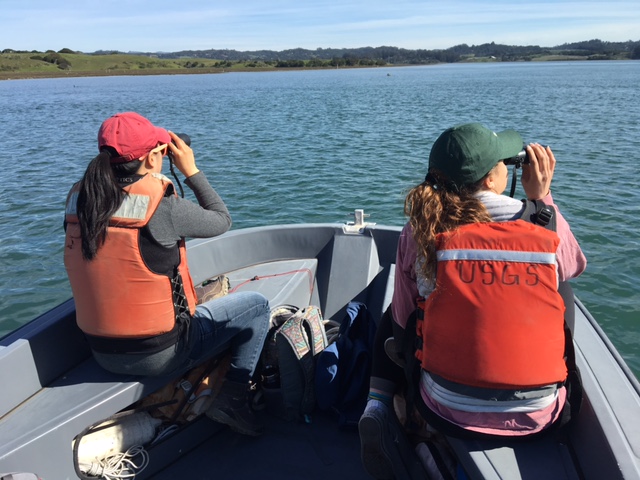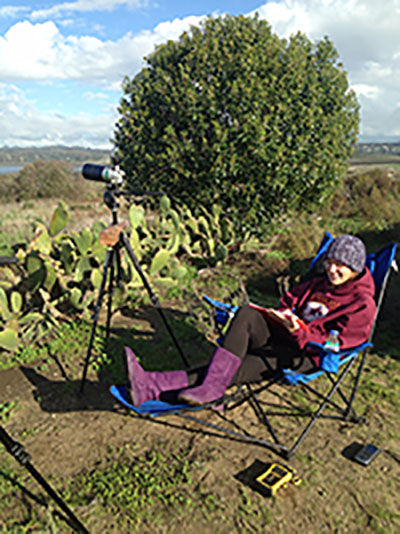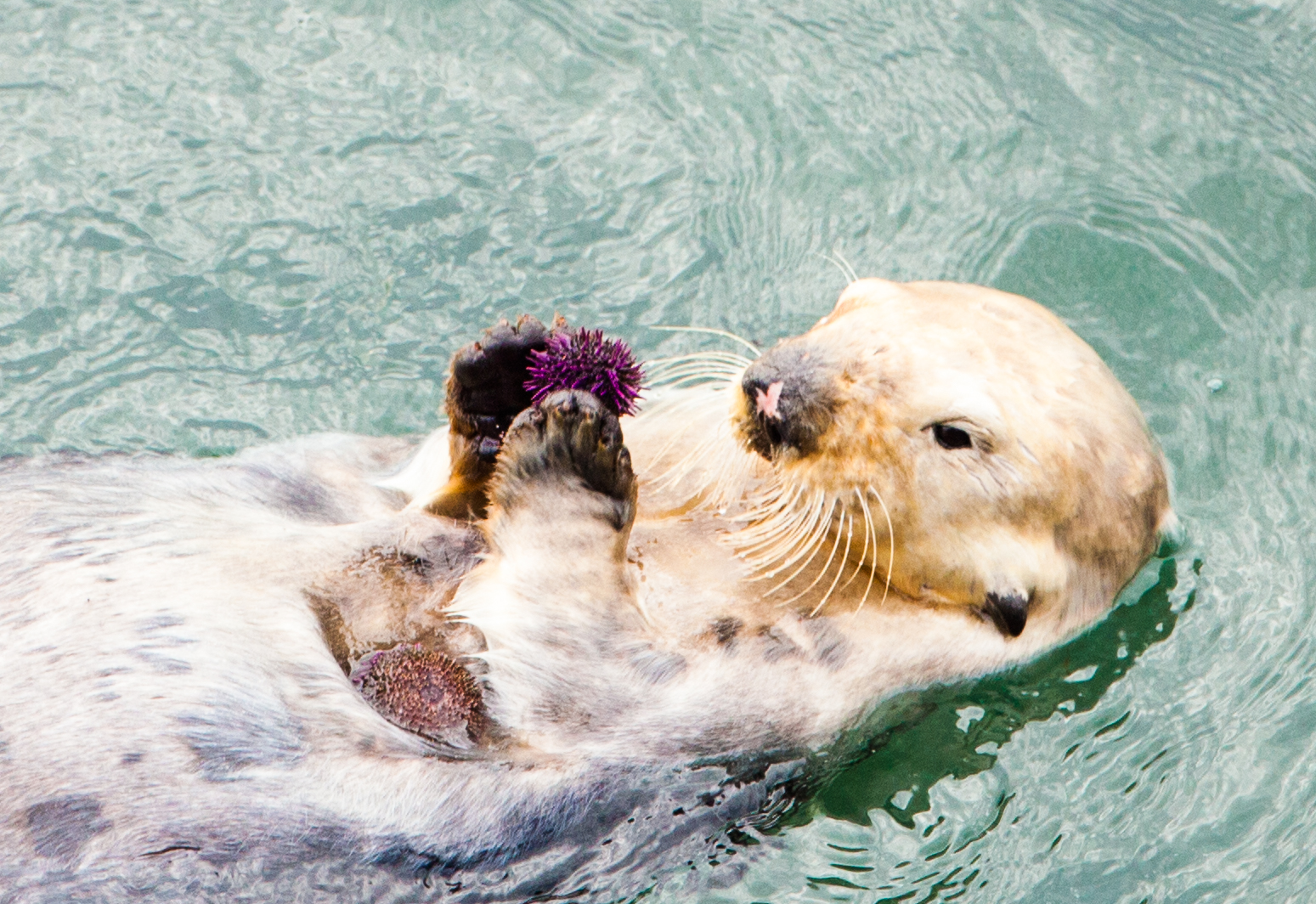| Home |
| Current Research |
| Graduate Students / Post Docs |
| Biologists / Technicians |
| Interns /Volunteers |
| Publications |
| Links |
| Our ftp site |
Interns & Volunteers
Background: The California sea otter population, listed as threatened under the Endangered Species Act, has shown a slow and intermittent rate of recovery over recent years. Proper conservation and management of this population requires reliable information on current and future trends in abundance and distribution, data on patterns and causes of mortality, and analyses of the demographic drivers of population change. The cooperative unit of USGS and UC Santa Cruz along with its collaborators in California has established a long-term research program to obtain that information. Telemetry-based population studies are ongoing in Monterey. In Monterey, sea otters are captured, bio-sampled, instrumented with VHF transmitters and archival time-depth recorders, and then released to be monitored for the subsequent 3 year period. Data are collected on age-specific survival, reproduction, individual health, contaminant exposure, disease incidence, diet and feeding behavior, activity budgets, individual movements and habitat use.
Monterey Predator Diversity Project: We are looking for enthusiastic and motivated individuals to assist staff with field observations and data collection of wild sea otters around the Monterey Peninsula in California. Study of sea otters, a threatened species under the U.S. Endangered Species Act, is the responsibility of the United States Geological Survey (USGS) housed at the Center for Ocean Health at the University of California, Santa Cruz. Interns will be trained to participate in radio tracking studies of sea otter behavior and population dynamics. The purpose of the current sea otter research is to determine whether sea otters will control rapid growth in the sea urchin populations. In 2015, along the West Coast of North America the sea star population plunged from sea star wasting disease. Historically, growth in the sea urchin population was kept in check by sea stars and sea otters, their natural predators. To learn more about the intership read the "Internship Announcement" below.
To perform this work, we are seeking 1-2 interns/volunteers for a minimum commitment of 6 months. Internships typically run from January-June and June-December.To apply for an internship email werc@ucsc.edu with your cover letter, CV, and 2 references.
Internship Application Questionaire


Possible Duties:
Sea Otter Monitoring
- The technician will regularly cover the study area, by vehicle or boat, in order to gather resights of all tagged and instrumented otters: the primary purpose of this procedure is to monitor the survival, reproductive status and movement of radio-tagged sea otters (study animals). A resight will consist of determining an otter’s location by triangulation from the transmitter signal and, if possible, by making visual identification. Radio instrumented otters are to be located using programmable scanning receivers, and visually identified using binoculars and high powered spotting scopes. When a study animal is located, the technician will record its geo-location (obtained using GPS and laser rangefinders) as well as environmental, demographic and behavioral parameters into a GIS-enabled database on a handheld computer. A resight for each study animal will be obtained every 1-2 days, weather permitting.
Activity Budget Data Collection
- The technician will collect data on activity time budgets of study animals by scheduling and conducting bi-weekly, 8-hour focal-animal monitoring sessions of study animals (such that all study animals are monitored at least once every 6 months). During these sessions, data are recorded at 10 minute intervals on behavior and geo-location, as well as environmental variables, and entered into a GIS-enabled database on a handheld computer.
Foraging Data Collection
- The technician will collect data on diet and foraging behavior by direct observation of feeding otters. In this procedure, the study animal is located (as described above) and observed using a Questar spotting scope (at 30x - 80x magnification). The data to be collected include the duration of each dive and subsequent surface time; whether or not the dive was successful; prey type; number and size of prey items caught; prey handling time, and various other information. Foraging data will be collected from all study animals on an opportunistic basis, although every attempt will be made to obtain roughly equivalent quantities of data from each Time Depth Recorder (TDR) instrumented animal.
Foraging Data Entry/Validation
- The technician will compile data submitted from field sites (which may include: Alaska, British Columbia, Washington, and California) into MS Excel or MS Access. Technician will standardize and validate data collected from foraging bout observations of otters, checking for observer errors in time, units, location, prey identification, etc. Technician will help to ensure data integrity and create summary reports to be used in scientific analysis and reporting.
For Undergraduates
We offer hands-on field experience for undergraduates in the form of accredited 5-unit internships though the University of California, Santa Cruz. We also work with dedicated students who are completing their senior comprehensive requirements. To work with us, we require a minimum commitment of 2 quarters, though we prefer to keep interns for a full academic year. Our interns are self-motivated, reliable, determined, and able to work both independently and as part of a dynamic team. Many have gone onto working with agencies such as the US Geological Survey, the US Fish and Wildlife Service, the Monterey Bay Aquarium, California Deptartment of Fish and Wildlife, and various ecological consulting firms. Others have gone on to become successful graduate students both here in Santa Cruz, and at other prestigious institutions around the country.
To apply for an internship or propose a project email werc@ucsc.edu with your cover letter, CV, and 2 references.
Contact Us: USGS Santa Cruz Field Station - 100 Shaffer Road - Center for Ocean Health - Room 251 - Santa Cruz, CA 95060 - 831 459-2357 - werc@ucsc.edu
